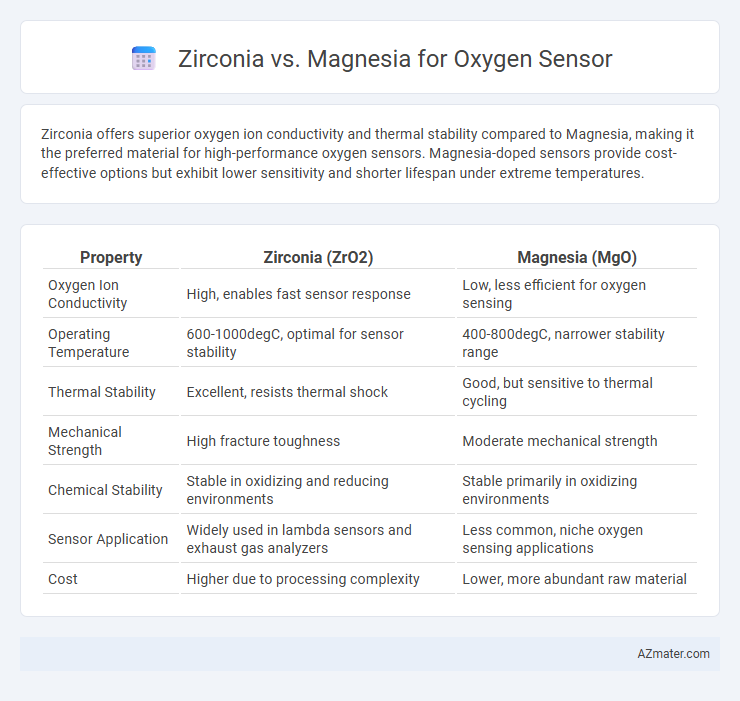Zirconia offers superior oxygen ion conductivity and thermal stability compared to Magnesia, making it the preferred material for high-performance oxygen sensors. Magnesia-doped sensors provide cost-effective options but exhibit lower sensitivity and shorter lifespan under extreme temperatures.
Table of Comparison
| Property | Zirconia (ZrO2) | Magnesia (MgO) |
|---|---|---|
| Oxygen Ion Conductivity | High, enables fast sensor response | Low, less efficient for oxygen sensing |
| Operating Temperature | 600-1000degC, optimal for sensor stability | 400-800degC, narrower stability range |
| Thermal Stability | Excellent, resists thermal shock | Good, but sensitive to thermal cycling |
| Mechanical Strength | High fracture toughness | Moderate mechanical strength |
| Chemical Stability | Stable in oxidizing and reducing environments | Stable primarily in oxidizing environments |
| Sensor Application | Widely used in lambda sensors and exhaust gas analyzers | Less common, niche oxygen sensing applications |
| Cost | Higher due to processing complexity | Lower, more abundant raw material |
Introduction to Oxygen Sensors
Oxygen sensors rely on materials like zirconia and magnesia to measure oxygen concentration by detecting differences in oxygen partial pressure. Zirconia-based sensors offer high ionic conductivity and excellent thermal stability, making them ideal for accurate and durable oxygen measurements in automotive and industrial applications. Magnesia, often used as a stabilizer in zirconia sensors, enhances mechanical strength and resistance to thermal shock, optimizing sensor performance under harsh operating conditions.
Overview of Zirconia Oxygen Sensors
Zirconia oxygen sensors utilize zirconium dioxide stabilized with yttria to provide high ionic conductivity, enabling accurate measurement of oxygen levels in exhaust gases. These sensors operate effectively at high temperatures around 600-900degC, producing a voltage signal proportional to the oxygen concentration difference between the exhaust and ambient air. Compared to magnesia-based sensors, zirconia sensors offer superior durability, sensitivity, and faster response times, making them the industry standard for automotive and industrial combustion monitoring.
Overview of Magnesia Oxygen Sensors
Magnesia oxygen sensors utilize magnesium oxide as a key electrolyte component, offering high ionic conductivity and stability at elevated temperatures above 600degC. These sensors exhibit fast response times and improved resistance to chemical poisoning compared to traditional zirconia-based sensors, making them suitable for harsh industrial environments. Their capability to maintain accurate oxygen partial pressure measurements enhances combustion control and emissions monitoring in power plants and automotive applications.
Key Material Properties: Zirconia vs Magnesia
Zirconia exhibits high oxygen ion conductivity and excellent thermal stability at elevated temperatures, making it ideal for oxygen sensors in harsh environments. Magnesia, while offering good chemical inertness and resistance to corrosion, shows lower ionic conductivity and less mechanical robustness under thermal cycling compared to zirconia. The superior phase stability and ionic transport properties of stabilized zirconia enhance sensor responsiveness and durability, outperforming magnesia-based materials in oxygen sensing applications.
Sensor Performance and Accuracy Comparison
Zirconia sensors exhibit superior oxygen ion conductivity and faster response times compared to magnesia-stabilized counterparts, resulting in higher sensor accuracy and reliability in automotive and industrial applications. Magnesia-stabilized sensors generally show lower thermal stability and slower oxygen ion transport, leading to less precise oxygen concentration measurements under dynamic operating conditions. Zirconia-based sensors maintain consistent sensor performance across a wider temperature range, enhancing their suitability for critical exhaust gas monitoring and emissions control systems.
Temperature Stability and Operating Range
Zirconia oxygen sensors exhibit superior temperature stability and operate efficiently within a high-temperature range of 300degC to 1000degC, making them ideal for automotive and industrial combustion applications. Magnesia-based sensors, on the other hand, demonstrate lower temperature stability and are typically used in moderate temperature environments below 800degC, limiting their application in extreme conditions. The high ionic conductivity and robust structural properties of stabilized zirconia ensure consistent oxygen ion conduction and sensor accuracy across fluctuating thermal conditions.
Durability and Longevity
Zirconia oxygen sensors exhibit superior durability and longevity due to their high resistance to thermal shock and chemical corrosion, maintaining stable performance in harsh environments up to 1000degC. Magnesia-based sensors, although cost-effective, tend to degrade faster under high-temperature conditions because of lower thermal stability and susceptibility to chemical wear. Consequently, zirconia sensors are preferred for long-term applications requiring consistent accuracy and reliability.
Application Suitability
Zirconia oxygen sensors excel in automotive exhaust and industrial furnace monitoring due to their high-temperature stability and rapid response in measuring oxygen concentration. Magnesia-based sensors offer enhanced durability under corrosive environments, making them suitable for harsh chemical processing applications where sensor longevity is critical. Selecting between zirconia and magnesia depends on operating temperature ranges, environmental conditions, and required sensor lifespan for optimal application performance.
Cost and Availability
Zirconia oxygen sensors generally have a higher initial cost but benefit from widespread availability and established manufacturing processes, making them cost-effective for large-scale applications. Magnesia-based sensors often feature lower raw material costs but are less common in the market, leading to limited supply and higher prices due to niche production. Evaluating total cost of ownership, including sensor lifespan and replacement frequency, is crucial when choosing between zirconia and magnesia for oxygen sensing applications.
Conclusion: Choosing Between Zirconia and Magnesia
Zirconia sensors exhibit superior oxygen ion conductivity and higher temperature stability, making them ideal for accurate and rapid oxygen level detection in automotive and industrial applications. Magnesia-based sensors offer enhanced resistance to chemical corrosion and lower manufacturing costs but generally provide slower response times and reduced sensitivity. Selecting between zirconia and magnesia depends on prioritizing durability and cost versus performance and precision in oxygen sensing environments.

Infographic: Zirconia vs Magnesia for Oxygen Sensor
 azmater.com
azmater.com